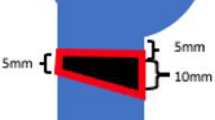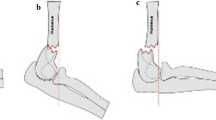Abstract
Purpose
Displaced type 2 lateral end clavicle fractures have a tendency to delayed union or non-union. Various methods of stabilisation of the displaced lateral end fractures are described. The increasing use of implants to fix such fractures also necessitates extensive dissection for implant retrieval. Adequate reduction and minimal tissue trauma during implant placement and removal would be ideal modalities for fixation of such fractures.
Methods
All displaced type 2 lateral end clavicle fractures fulfilling our inclusion criteria were reduced with a small anterosuperior incision. Anteroposterior drill holes were made in both the fragments and a nonabsorabable polyester suture was passed through. The fracture was reduced and fixed with transacromial smooth Kirshner wires. The suture was tied with the knot superiorly in a figure-eight manner. The arm was supported in an arm pouch for six weeks. The Kirshner wire was routinely removed after six weeks in an out-patient department. Clinico-radiological outcome was studied at six weeks, and monthly intervals thereafter until union.
Results
All 16 fractures united. The mean average age of patients was 36.25 years with a SD of 11.35. There was no loss of reduction even after removal of Kirshner wires at six weeks. The mean average time of union was 10.75 weeks with a SD of 3.92. All patients regained near normal range of motion, and the mean average constant score at the end of one year was 98.37 with a SD of 2.87. All patients returned to preinjury level by the one-year follow-up. The range of motion remained the same in those who were followed up in successive years. Skin impingement with bent Kirshner wires were noted in four cases. Kirshner wires backed out in one case before six weeks but there was no loss of reduction. Infection and Kirshner wire breakage were not noted in our series.
Conclusion
The clinico-radiological outcomes with our modified tension band fixation for displaced type 2 lateral end clavicle fractures were encouraging and comparable with earlier studies.



Similar content being viewed by others
References
Neer CS (1968) Fractures of the distal third of the clavicle. Clin Orthop Relat Res 58:43–50
Robinson CM, Cairns DA (2004) Primary nonoperative treatment of displaced lateral fractures of the clavicle. J Bone Joint Surg Am 86-A(4):778–782
Neviaser JS (1963) The treatment of fractures of the clavicle. Surg Clin North Am 43:1555–1563
Zenni EJ Jr, Krieg JK, Rosen MJ (1981) Open reduction and internal fixation of clavicular fractures. J Bone Joint Surg Am 63(1):147–151
Eskola A, Vainionpaa S, Patiala H, Rokkanen P (1987) Outcome of operative treatment in fresh lateral clavicular fracture. Ann Chir Gynaecol 76(3):167–169
Robinson CM, Court-Brown CM, McQueen MM, Wakefield AE (2004) Estimating the risk of nonunion following nonoperative treatment of a clavicular fracture. J Bone Joint Surg Am 86:1359–1365
Ballmer FT, Gerber C (1991) Coracoclavicular screw fixation for unstable fractures of the distal clavicle. A report of five cases. J Bone Joint Surg Br 73:291–294
Macheras G, Kateros KT, Savvidou OD, Sofianos J, Fawzy EA, Papagelopoulos PJ (2005) Coracoclavicular screw fixation for unstable distal clavicle fractures. Orthopedics 28:693–696
Yamaguchi H, Arakawa H, Kobayashi M (1998) Results of the Bosworth method for unstable fractures of the distal clavicle. Int Orthop 22:366–368
Bezer M, Aydin N, Guven O (2005) The treatment of distal clavicle fractures with coracoclavicular ligament disruption: a report of 10 cases. J Orthop Trauma 19:524–528
Chen CH, Chen WJ, Shih CH (2002) Surgical treatment for distal clavicle fracture with coracoclavicular ligament disruption. J Trauma 52:72–78
Shin SJ, Roh KJ, Kim JO, Sohn HS (2009) Treatment of unstable distal clavicle fractures using two suture anchors and suture tension bands. Injury 40:1308–1312
Kona J, Bosse MJ, Staeheli JW, Rosseau RL (1990) Type II distal clavicle fractures: a retrospective review of surgical treatment. J Orthop Trauma 4(2):115–120
Haidar SG, Krishnan KM, Deshmukh SC (2006) Hook plate fixation for type II fractures of the lateral end of the clavicle. J Shoulder Elbow Surg 15:419–423
Klein SM, Badman BL, Keating CJ, Devinney DS, Frankle MA, Mighell MA (2010) Results of surgical treatment for unstable distal clavicular fractures. J Shoulder Elbow Surg 19:1049–1055
Herrmann S, Schmidmaier G, Greiner S (2009) Stabilisation of vertical unstable distal clavicular fractures (Neer 2b) using locking T-plates and suture anchors. Injury 40:236–239
Kaipel M, Majewski M, Regazzoni P (2010) Double-plate fixation in lateral clavicle fractures—a new strategy. J Trauma 69:896–900
Yu C, Sun YH, Zhao CQ, Shi DW, Wang Y (2009) Treatment of distal clavicle fracture with distal radius volar locking compression plate. Chin J Traumatol 12:299–301
Brouwer KM, Wright TC, Ring DC (2009) Failure of superior locking clavicle plate by axial pull-out of the lateral screws: a report of four cases. J Shoulder Elbow Surg 18:e22–e25
Levy O (2003) Simple, minimally invasive surgical technique for treatment of type 2 fractures of the distal clavicle. J Shoulder Elbow Surg 12:24–28
Badhe SP, Lawrence TM, Clark DI (2007) Tension band suturing for the treatment of displaced type 2 lateral end clavicle fractures. Arch Orthop Trauma Surg 127(1):25–28
Nadarajah R, Mahaluxmivala J, Amin A, Goodier DW (2005) Clavicular hook-plate: complications of retaining the implant. Injury 36(5):681–683
Edwards DJ, Kavanagh TG, Flannery MC (1992) Fractures of the distal clavicle: a case for fixation. Injury 23(1):44–46
Goldberg JA, Bruce WJ, Sonnabend DH, Walsh WR (1997) Type II fractures of the distal clavicle: a new surgical technique. J Shoulder Elbow Surg 6:380–382
Tambe AD, Motkar P, Qamar A, Drew S, Turner SM (2006) Fracture of distal third of the clavicle treated by hook plate. Int Orthop 30(1):7–10
Lee YS, Lau MJ, Tseng YC, Chen WC, Kao HY, Wei JD (2009) Comparison of the efficacy of hook plate versus tension band wire in the treatment of unstable fractures of the distal clavicle. Int Orthop 33(5):1401–1405
Andersen JR, Willis MP, Nelson R, Mighell MA (2011) Precontoured superior locked plating of distal clavicle fractures: a new strategy. Clin Orthop Relat Res 469(12):3344–3350
Conflict of interest
No conflict of interest exists.
Author information
Authors and Affiliations
Corresponding author
Rights and permissions
About this article
Cite this article
Rijal, L., Sagar, G., Joshi, A. et al. Modified tension band for displaced type 2 lateral end clavicle fractures. International Orthopaedics (SICOT) 36, 1417–1422 (2012). https://doi.org/10.1007/s00264-012-1514-9
Received:
Accepted:
Published:
Issue Date:
DOI: https://doi.org/10.1007/s00264-012-1514-9




